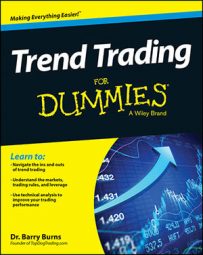You find wave and cycle highs and lows with the cycle indicator. The cycle indicator defines the highs and lows and shows that they’re significant; they draw a line in the sand as to whether the market is progressing up or down as the market wiggles within its trend. Here is an example of how the cycle indicator helps locate cycle highs and lows in price bar formations.
![[Credit: Figure by Barry Burns]](https://www.dummies.com/wp-content/uploads/448349.image0.jpg)
In an ideal uptrend, each cycle high is higher than the previous cycle high. In an ideal downtrend, each cycle low is lower than the previous cycle low.
Unfortunately, markets aren’t this neat and tidy. Even though not every cycle high/low follows this pattern, a good uptrend follows this pattern with most cycle highs/lows.
Every uptrend is a series of broken resistance levels. Every downtrend is a series of broken support levels. This leads to the concept of waves. Waves in an uptrend are cycle highs that make a higher high than the previous wave high.
![[Credit: Figure by Barry Burns]](https://www.dummies.com/wp-content/uploads/448350.image1.jpg)
A wave low in an uptrend is simply the lowest cycle low between the two wave highs. Waves in a downtrend are cycle lows that make lower lows than the previous wave low. Wave highs in a downtrend are simply the highest cycle high between two wave lows.
![[Credit: Figure by Barry Burns]](https://www.dummies.com/wp-content/uploads/448351.image2.jpg)
Cycle highs and lows produce visible highs and lows in the fluctuation of the market wiggling up and down. Other traders can see these highs and lows and may respond to them as support/resistance levels. The more traders see them, the more likely those levels are to provide support and resistance as traders either buy/sell off of them or take profits into them.
![[Credit: Figure by Barry Burns]](https://www.dummies.com/wp-content/uploads/448352.image3.jpg)
Now you have an objective tool for identifying significant highs and lows instead of just using your visual discretion to find the highs and lows that stand out on a chart. The following rules then become evident:
Waves are more likely to provide support/resistance because they’re more visually prominent on the charts.
Waves and cycles on longer-term time frames are more likely to provide support/resistance because those who trade long-term and short-term charts alike will see them.
Wave and cycle support/resistance work equally well for any market you may be trading. They’re also applicable to day trading, swing trading, and investing time frames.

